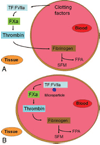The role of tissue factor and factor VIIa in hemostasis
- PMID: 19372318
- PMCID: PMC2838713
- DOI: 10.1213/ane.0b013e31819bceb1
The role of tissue factor and factor VIIa in hemostasis
Abstract
Tissue factor (TF) is a transmembrane receptor for Factor VII/VIIa (FVII/VIIa). It is constitutively expressed by cells surrounding blood vessels. The endothelium physically separates this potent "activator" from its circulating ligand FVII/FVIIa and prevents inappropriate activation of the clotting cascade. Breakage of the endothelial barrier leads to exposure of extravascular TF and rapid activation of the clotting cascade. TF is also expressed in certain tissues, such as the heart and brain, and provides additional hemostatic protection to these tissues. Small amounts of TF are also present in blood in the form of microparticles, which are small membrane vesicles derived from activated and apoptotic cells. Levels of microparticle TF increase in a variety of diseases, such as sepsis and cancer, and this so-called "blood-borne" TF may contribute to thrombosis associated with these diseases. Recombinant FVIIa has been developed as an effective hemostatic drug for the treatment of hemophilia patients with inhibitory antibodies. In addition, it is used for patients with bleeding that do not respond to conventional therapy. However, the mechanism by which recombinant FVIIa restores hemostasis has not been clearly defined. In conclusion, the TF:FVIIa complex is essential for hemostasis and recombinant FVIIa is an effective hemostatic drug.
Conflict of interest statement
The author has no conflict of interest related to this review.
Figures




References
-
- Davie EW, Fujikawa K, Kisiel W. The coagulation cascade: initiation, maintenance, and regulation. Biochemistry. 1991;30:10363–10370. - PubMed
-
- Edgington TS, Mackman N, Brand K, Ruf W. The structural biology of expression and function of tissue factor. Thromb Haemost. 1991;66:67–79. - PubMed
-
- Nemerson Y. Tissue factor and hemostasis. Blood. 1988;71:1–8. - PubMed
-
- Gilani D, Renne T. Intrinsic pathway of coagulation and arterial thrombosis. Arterioscler Thromb Vasc Biol. 2007:2507–2513. - PubMed
-
- Coughlin SR. Thrombin signalling and protease-activated receptors. Nature. 2000;407:258–264. - PubMed
Publication types
MeSH terms
Substances
Grants and funding
LinkOut - more resources
Full Text Sources
Other Literature Sources
Molecular Biology Databases
Miscellaneous

